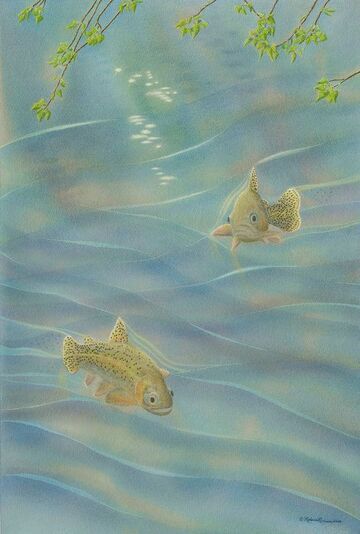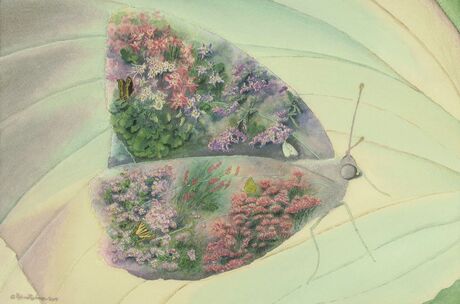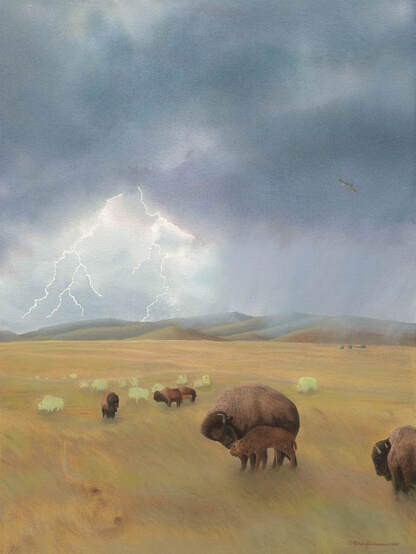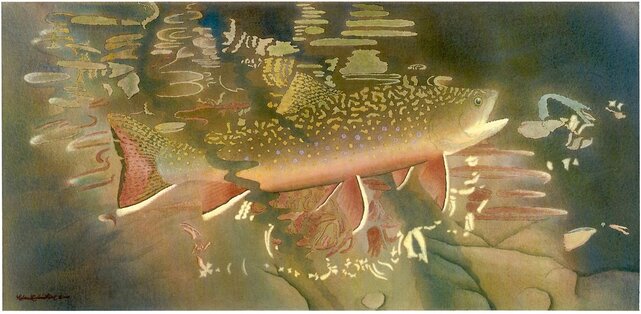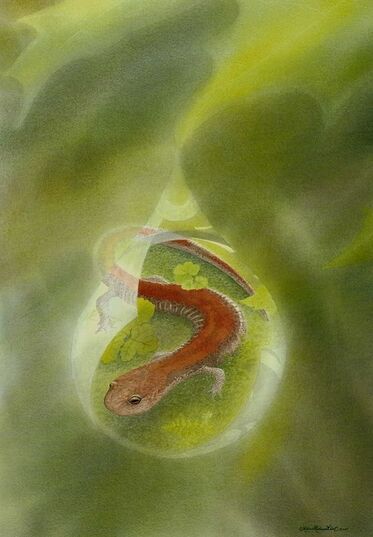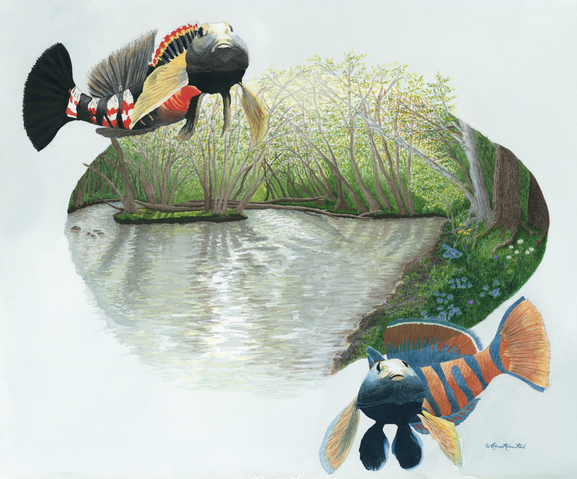Fauna
Click on each image to enlarge.
In addition to butterflies, moths, and hummingbirds, bumble bees are wonderful pollinators of wildflowers, like the Goldenrod, Wild Rose, and Penstemon in my painting which are very important food sources for the bees. The center focus of this image is a female bumble bee native to Colorado (Bombus balteatus), as she explores a Rose Crown cluster of flowers that grows up to 12 inches tall in subalpine and alpine regions of the West.
These amazing little creatures also perform buzz pollination which occurs from the strong vibration of the bee’s wing muscles, shaking pollen from blooms which benefits many flowering plants, including fruit and vegetable crops such as blueberries, cranberries, and tomatoes.
Bumble bees are the only true social bees native to North America, living in colonies and having overlapping generations. They are also active in lower light and cooler weather conditions, more so than any other bees, which increases their impact for pollination.
A favorite quote by May Kay Ash inspires us. ”Aerodynamically, the bumble bee shouldn't be able to fly, but the bumble bee doesn't know it so it goes on flying anyway.” So if a bumble bee can fly with its big fuzzy body and relatively tiny wings, then we too, can do the miraculous!
See Original ~ See Print
These amazing little creatures also perform buzz pollination which occurs from the strong vibration of the bee’s wing muscles, shaking pollen from blooms which benefits many flowering plants, including fruit and vegetable crops such as blueberries, cranberries, and tomatoes.
Bumble bees are the only true social bees native to North America, living in colonies and having overlapping generations. They are also active in lower light and cooler weather conditions, more so than any other bees, which increases their impact for pollination.
A favorite quote by May Kay Ash inspires us. ”Aerodynamically, the bumble bee shouldn't be able to fly, but the bumble bee doesn't know it so it goes on flying anyway.” So if a bumble bee can fly with its big fuzzy body and relatively tiny wings, then we too, can do the miraculous!
See Original ~ See Print
Do crayfish, trees, and other river life miss the trout when they’re gone? Ecologists, wildlife biologists, and naturalists are discovering that plants and animals know and feel way more than we ever imagined.
My painting, Home for Greenback Cutthroat Trout, highlights two worlds at once. New spring leaves dangle over the pristine water as sunlight sparkles on the surface of the creek. Then we see beneath, two trout peaceful in their native home. Rays of golden light shimmer on the edge of shadows created by their sleek bodies. The rare fish leave signs of their presence as they glide through the current, at one with all that surrounds them.
The greenback cutthroat trout is the Colorado State Fish and is listed as threatened, primarily due to habitat loss and aquatic pollution. Land managers and conservationists are testing ways to increase greenback populations throughout their natural range.
When we’re away from our favorite stream or river, do the trout miss us when we’re gone?
See Original ~ See Print
My painting, Home for Greenback Cutthroat Trout, highlights two worlds at once. New spring leaves dangle over the pristine water as sunlight sparkles on the surface of the creek. Then we see beneath, two trout peaceful in their native home. Rays of golden light shimmer on the edge of shadows created by their sleek bodies. The rare fish leave signs of their presence as they glide through the current, at one with all that surrounds them.
The greenback cutthroat trout is the Colorado State Fish and is listed as threatened, primarily due to habitat loss and aquatic pollution. Land managers and conservationists are testing ways to increase greenback populations throughout their natural range.
When we’re away from our favorite stream or river, do the trout miss us when we’re gone?
See Original ~ See Print
Butterflies! These delicate, yet mighty creatures are such a wonder! They’re fondly referred to as flying flowers and I can understand why. Butterflies display so many vivid colors and patterns, and up close their wings have a subtle shimmer just like flower petals. They’re light as a feather and ever graceful as they drift on a warm summer breeze, yet hardy enough to weather a rain shower.
Butterflies, like bees and moths, are incredibly important to the pollination of our diverse plant kingdom. It’s not an exaggeration to say that all life depends on pollinators to fertilize the world’s flowers, enabling seeds to form and plants to reproduce.
In my painting, Home for Butterflies, these wildflowers are some of my favorites. Columbine, sage, milkweed, and asters all flourish due to our pollinators. And in turn, black and tiger swallowtails, cabbage whites and clouded sulphurs thrive because of our native wildflowers. What a beautiful relationship!
The amazing connection between plants and butterflies is celebrated in this image; the butterfly wing surrounding pockets of pretty wildflowers within the intricate butterfly form. All one in the unity of life!
See Original ~ See Print
Butterflies, like bees and moths, are incredibly important to the pollination of our diverse plant kingdom. It’s not an exaggeration to say that all life depends on pollinators to fertilize the world’s flowers, enabling seeds to form and plants to reproduce.
In my painting, Home for Butterflies, these wildflowers are some of my favorites. Columbine, sage, milkweed, and asters all flourish due to our pollinators. And in turn, black and tiger swallowtails, cabbage whites and clouded sulphurs thrive because of our native wildflowers. What a beautiful relationship!
The amazing connection between plants and butterflies is celebrated in this image; the butterfly wing surrounding pockets of pretty wildflowers within the intricate butterfly form. All one in the unity of life!
See Original ~ See Print
This painting shows one of the high alpine ponds at Mexican Cut, a Nature Conservancy preserve near Crested Butte, Colorado. Scientists are studying the effects of climate change and acid rain on the composition of these glacial pools and wetlands. Tiger salamanders are part of this important work because many individuals in this location don't fully develop and remain partly in their aquatic form with two front legs and a tail, never leaving the water. As you look closely, see the clouds in the shape of salamanders. See their reflections in this quiet pool. As high alpine ponds become more pristine as a result of less pollution, the populations of our beloved tiger salamanders will become more viable.
See Original ~ See Print
See Original ~ See Print
This image brings attention to the ever important predator/prey relationships in nature. Every species is connected to the whole. As you look closely, within the aspen leaves, you’ll recognize footprints of animals critical to the survival of wolves, such as moose, bison, deer, elk, snowshoe hare, jack rabbit and bighorn sheep — all herbivores woven perfectly into the tapestry of life; as is the wolf, a predator who keeps prey populations healthy. Within the leaves throughout the painting, I’ve placed shadows and images of wolves to highlight the important social hierarchy of the pack.
From Of Wolves and Men by author, Barry Lopez, “The appreciation of the separate realities enjoyed by other organisms is not only no threat to our own reality, but the root of a fundamental joy. I learned from River that I was a human being and that he was a wolf and that we were different. I valued him as a creature, but he did not have to be what I imagined he was. It is with this freedom from dogma, I think, that the meaning of the words ‘the celebration of life’ becomes clear.”
See Original ~ See Print
From Of Wolves and Men by author, Barry Lopez, “The appreciation of the separate realities enjoyed by other organisms is not only no threat to our own reality, but the root of a fundamental joy. I learned from River that I was a human being and that he was a wolf and that we were different. I valued him as a creature, but he did not have to be what I imagined he was. It is with this freedom from dogma, I think, that the meaning of the words ‘the celebration of life’ becomes clear.”
See Original ~ See Print
Imagine the preservation of the Great Plains, a place where bison herds can once again roam free. A place where the ferruginous hawk flies peacefully overhead. Imagine the rare white buffalo, a sign of new beginnings according to some Native American Indian tribes. If you look closely, you can see the white buffalo as one with the wind swept prairie grasses (bottom left corner). Imagine people and wild creatures living in harmony and balance. Imagine bison as one with the prairie.
See Print
See Print
The black-tailed prairie dog, a hallmark of the American West, is a keystone species that many plants and animals depend on. We grow fond of these darling creatures as we watch them scamper here and there along trails and roadways in our nation’s grasslands. We need prairie dogs. They increase vegetation health by regularly cropping grasses and herbs. Short plants provide a better source of protein to the grazers that feed on them, such as bison, antelope, deer and elk. Prairie dog burrows provide shelter to mountain plovers, burrowing owls and black-footed ferrets; species listed as threatened or endangered. In this painting, I focus on these rare species and prairie dogs to illustrate that every life form is connected, a universal theme throughout my work.
See Original ~ See Print
See Original ~ See Print
The brookie, a highly sensitive and fragile trout species, is an indicator of the health of our freshwater systems in some very special places such as Maine, New Hampshire, Vermont, and the Adirondack Mountains of New York. What a gorgeous creature the brook trout is! The colors, the fluid movement, the honesty. Look closely at this strong beautiful trout. See its reflection sparkling in the ripples of the river. Feel its connection to the water where it lives. See the brookie as one with its home. Discover your own connection with the waters of the Earth.
See Print
See Print
The red-backed salamander is a sensitive inhabitant of our natural world, and its recent population decline can tell us about the viability of our eastern forests. Acid rain is affecting the homes of these tiny beings; creatures who are helping us to educate people and stop pollution. Each drop of water falling from the sky should be pure and clean and sparkling!
See Print
See Print
Imagine viable populations of mayflies and trout. Imagine clean, pure snow melting into our rivers and streams each spring. Imagine the web of life within each ice crystal, snowflake, or frozen stream surface; a web that is connected by weather, water, bugs, trout, and people. Our thoughtful choices can make these relationships healthy again, abating the threat of pollution forever and returning to a time of clean skies and pristine waters.
See Print
See Print
Living in both Big and Little Darby Creeks in central Ohio, these brilliantly-colored darters thrive in healthy freshwater streams and rivers.
See Print
See Print


